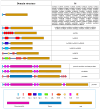The Set of Serine Peptidases of the Tenebrio molitor Beetle: Transcriptomic Analysis on Different Developmental Stages
- PMID: 38891931
- PMCID: PMC11172050
- DOI: 10.3390/ijms25115743
The Set of Serine Peptidases of the Tenebrio molitor Beetle: Transcriptomic Analysis on Different Developmental Stages
Abstract
Serine peptidases (SPs) of the chymotrypsin S1A subfamily are an extensive group of enzymes found in all animal organisms, including insects. Here, we provide analysis of SPs in the yellow mealworm Tenebrio molitor transcriptomes and genomes datasets and profile their expression patterns at various stages of ontogeny. A total of 269 SPs were identified, including 137 with conserved catalytic triad residues, while 125 others lacking conservation were proposed as non-active serine peptidase homologs (SPHs). Seven deduced sequences exhibit a complex domain organization with two or three peptidase units (domains), predicted both as active or non-active. The largest group of 84 SPs and 102 SPHs had no regulatory domains in the propeptide, and the majority of them were expressed only in the feeding life stages, larvae and adults, presumably playing an important role in digestion. The remaining 53 SPs and 23 SPHs had different regulatory domains, showed constitutive or upregulated expression at eggs or/and pupae stages, participating in regulation of various physiological processes. The majority of polypeptidases were mainly expressed at the pupal and adult stages. The data obtained expand our knowledge on SPs/SPHs and provide the basis for further studies of the functions of proteins from the S1A subfamily in T. molitor.
Keywords: Tenebrio molitor; digestion; expression patterns; phylogenetic analysis; polypeptidases; serine peptidase homologs; serine peptidases.
Conflict of interest statement
The authors declare no conflicts of interest.
Figures






Similar articles
-
Identification and expression profiling of serine protease-related genes in Tenebrio molitor.Arch Insect Biochem Physiol. 2022 Nov;111(3):e21963. doi: 10.1002/arch.21963. Epub 2022 Aug 30. Arch Insect Biochem Physiol. 2022. PMID: 36039637
-
Bacillus thuringiensis Cry3Aa protoxin intoxication of Tenebrio molitor induces widespread changes in the expression of serine peptidase transcripts.Comp Biochem Physiol Part D Genomics Proteomics. 2012 Sep;7(3):233-42. doi: 10.1016/j.cbd.2012.03.005. Epub 2012 May 2. Comp Biochem Physiol Part D Genomics Proteomics. 2012. PMID: 22640634
-
Dipeptidyl peptidase 4 - An important digestive peptidase in Tenebrio molitor larvae.Insect Biochem Mol Biol. 2016 Sep;76:38-48. doi: 10.1016/j.ibmb.2016.07.003. Epub 2016 Jul 6. Insect Biochem Mol Biol. 2016. PMID: 27395781
-
Drosophila melanogaster clip-domain serine proteases: Structure, function and regulation.Biochimie. 2016 Mar;122:255-69. doi: 10.1016/j.biochi.2015.10.007. Epub 2015 Oct 8. Biochimie. 2016. PMID: 26453810 Review.
-
Autophagy in Tenebrio molitor Immunity: Conserved Antimicrobial Functions in Insect Defenses.Front Immunol. 2021 May 31;12:667664. doi: 10.3389/fimmu.2021.667664. eCollection 2021. Front Immunol. 2021. PMID: 34135896 Free PMC article. Review.
Cited by
-
Special Issue "Transcriptomics in the Study of Insect Biology".Int J Mol Sci. 2024 Nov 22;25(23):12582. doi: 10.3390/ijms252312582. Int J Mol Sci. 2024. PMID: 39684294 Free PMC article.
References
-
- Choo Y.M., Lee K.S., Yoon H.J., Lee S.B., Kim J.H., Sohn H.D., Jin B.R. A serine protease from the midgut of the bumblebee, Bombus ignites (Hymenoptera: Apidae): cDNA cloning, gene structure, expression and enzyme activity. Eur. J. Entomol. 2007;104:1–7. doi: 10.14411/eje.2007.001. - DOI
-
- Waterhouse R.M., Kriventseva E.V., Meister S., Xi Z., Alvarez K.S., Bartholomay L.C., Barillas-Mury C., Bian G., Blandin S., Christensen B.M., et al. Evolutionary dynamics of immune-related genes and pathways in disease-vector mosquitoes. Science. 2007;316:1738–1743. doi: 10.1126/science.1139862. - DOI - PMC - PubMed
MeSH terms
Substances
Grants and funding
LinkOut - more resources
Full Text Sources

